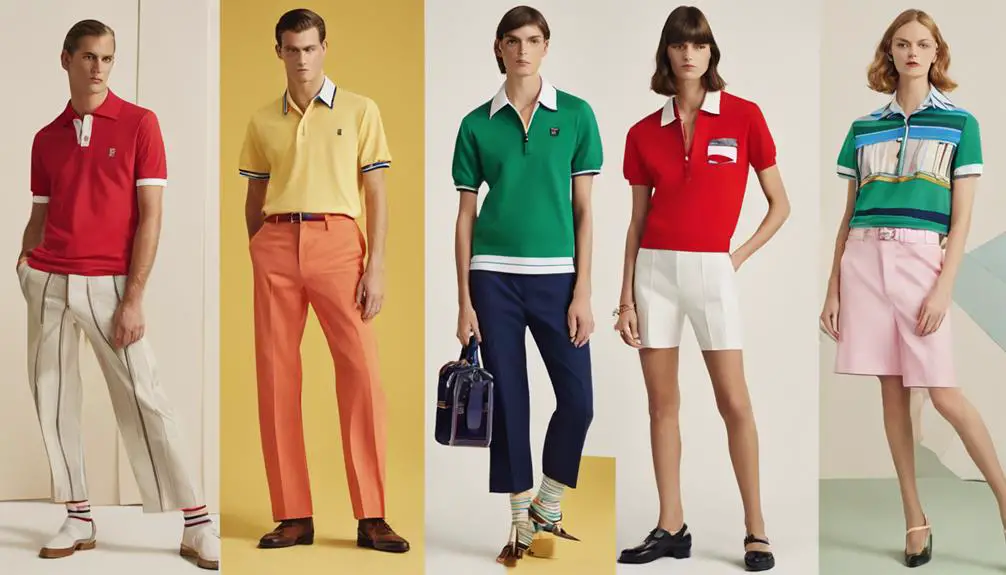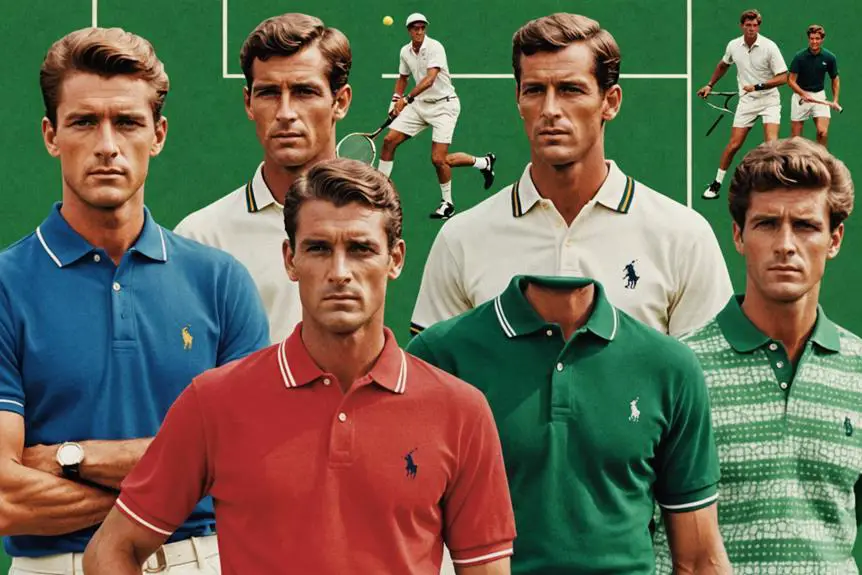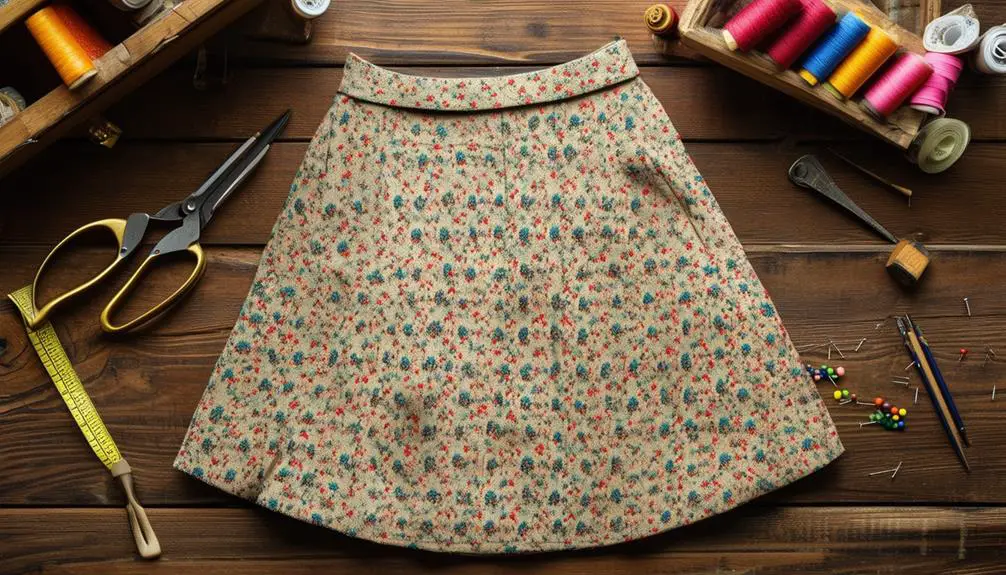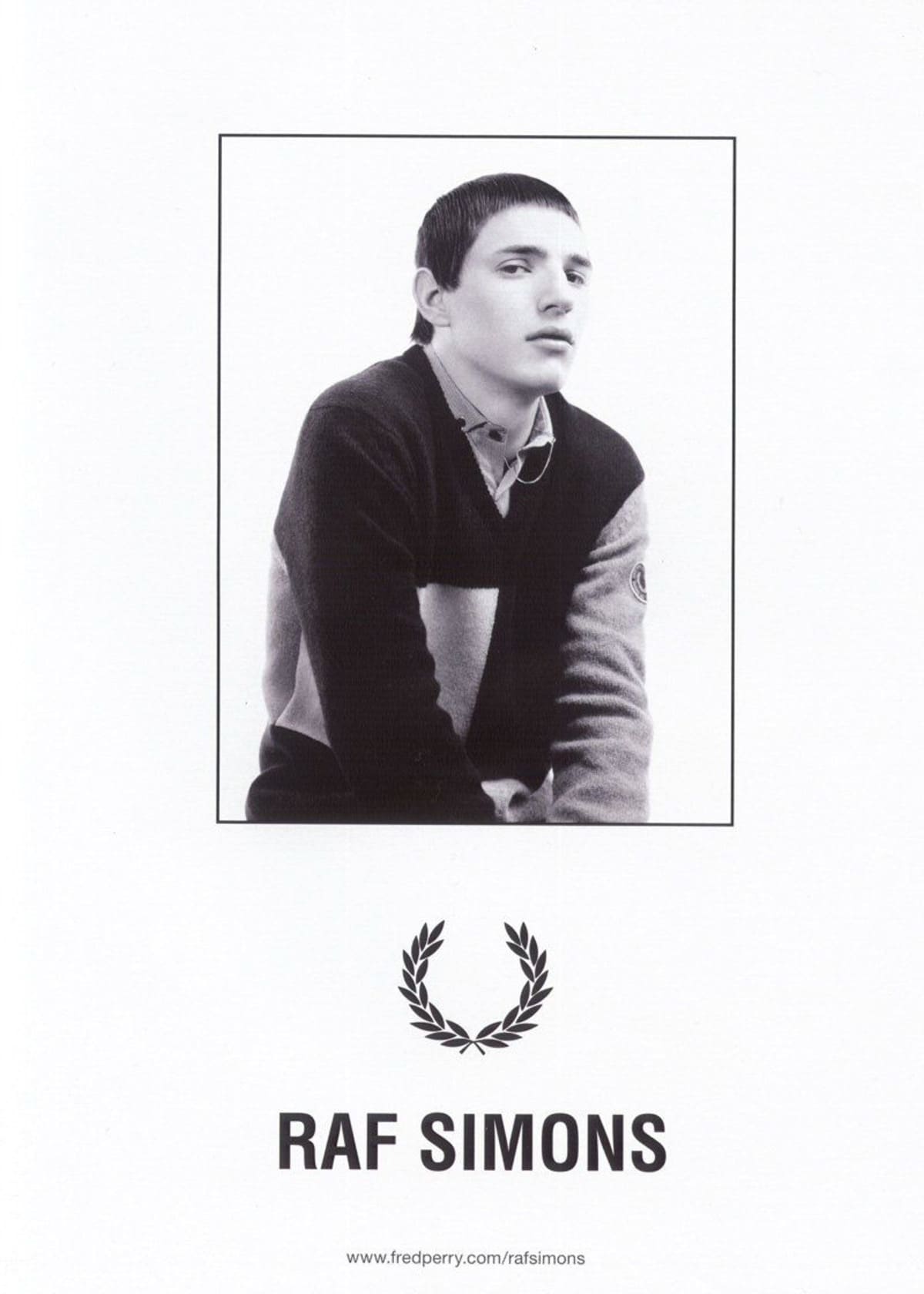You might find it intriguing how the polo shirt, a staple in many wardrobes today, traces its roots back to early 20th century India, designed for polo players. As you explore its transformation through René Lacoste's influence in tennis and its rise as a fashion statement in the 1980s, you'll uncover the garment's evolution into a symbol of status. But what does its journey reveal about our changing perceptions of style and sustainability? The answer might surprise you, as the polo shirt continues to adapt in today's fashion landscape.
Origins of the Polo Shirt

Although the polo shirt is often associated with modern sportswear, its origins trace back to early 20th century India, where it was specifically designed for polo players seeking comfort and breathability. Initially, the first version of the polo shirt featured long sleeves made of wool, which later evolved into the short sleeves we recognize today. This evolution made it more adaptable for various activities, much like how vintage Ralph Lauren items offer distinct characteristics that reflect their rich history.
A significant moment in the shirt's history occurred when John E. Brooks patented the button-down collar in 1896. Inspired by British gentry, this design helped prevent collar flapping during intense polo matches, enhancing practicality for players. Fast forward to 1926, when Renée Lacoste took the polo shirt to new heights by designing a modern version for tennis, crafted from knitted cotton and featuring a soft collar. His innovation made the polo shirt a staple in sports and casual wear alike.
Today, the polo shirt stands as a versatile fashion item, bridging the gap between casual and formal attire. Its rich history reflects a blend of functionality and style, making it a beloved choice in wardrobes around the world.
Renée Lacoste's Innovation
Renée Lacoste fundamentally changed the polo shirt's landscape in 1929 by introducing the modern piqué version, designed specifically for comfort on the tennis court. You can imagine the relief players felt as they swapped traditional long-sleeved attire for Lacoste's short-sleeved design, featuring a soft collar that allowed for greater freedom of movement. This classic white shirt, adorned with an embroidered crocodile logo—Lacoste's nickname—quickly became a symbol of sporty sophistication. Lacoste's innovation in casual wear parallels Ralph Lauren's launch of the Polo Shirt in 1972, which further established the garment as a luxury staple in American fashion, celebrated for its cultural impact.
In 1933, Lacoste partnered with André Gillier to launch "La Chemise Lacoste," which greatly boosted production and popularity across Europe and North America. By the 1930s, Lacoste's shirts were flying off the shelves, with annual sales reaching an impressive 300,000 units. This surge established the polo shirt as a staple in sporty leisure-class fashion.
Lacoste's innovation didn't just revolutionize sportswear; it elevated the polo shirt to a symbol of casual elegance and style that remains relevant today. Whether you're hitting the tennis courts or enjoying a weekend outing, wearing a Lacoste polo shirt connects you to a rich history of comfort and sophistication, making it a timeless addition to any wardrobe.
Evolution Into Fashion

As you explore the evolution of the polo shirt, you'll see how this once-simple sports garment transformed into a beloved casual staple by the 1970s, thanks to influential brands like Ralph Lauren. The origins of the polo shirt can be traced back to sportswear innovations, such as those by Fred Perry, which focused on merging functionality with style. With its vibrant colors and stylish cuts, the polo shirt not only gained popularity among leisure enthusiasts but also became a symbol of status in the preppy style of the 1980s. Today, it stands as a versatile piece that effortlessly bridges the gap between formal and casual wear, reflecting both timeless charm and modern trends.
Sportswear to Casual Staple
Transforming from a functional sports garment to a casual staple, the polo shirt has undergone a fascinating evolution that reflects changes in both fashion and lifestyle. Initially designed by Renée Lacoste in the 1920s, the piqué polo shirt featured breathable cotton fabric and short sleeves, making it popular among athletes and casual wearers alike. This shift marked the beginning of the polo shirt's journey into everyday fashion.
In the 1970s, Ralph Lauren played a significant role in popularizing polo shirts as smart-casual attire. By introducing a variety of colors and the iconic pony logo, he helped elevate the garment's status beyond sports. Throughout the 1980s, the polo shirt became synonymous with preppy style, representing a refined sense of casual elegance often associated with the upper class.
Today, the polo shirt continues to evolve, incorporating modern design elements and sustainable materials that appeal to a fashion-conscious audience. Its versatility allows it to shift seamlessly from a day on the golf course to a night out, proving that this timeless piece remains a wardrobe essential that balances comfort, style, and sophistication.
Influential Fashion Brands
The polo shirt's rise in fashion prominence can be largely attributed to influential brands that have shaped its identity over the decades. Ralph Lauren, who coined the term "polo shirt" in the 1970s, played a pivotal role in elevating the garment's status. By introducing a variety of colors and the iconic pony logo, he cemented its place as a staple in smart-casual fashion. Similarly, Lacoste's partnership with André Gillier in 1933 popularized the piqué cotton polo, making it a symbol of sporty leisure-class style with impressive sales.
Here are some key players that transformed the polo shirt landscape:
- Lacoste: Pioneered the piqué polo shirt, establishing a sporty image.
- Ralph Lauren: Defined smart-casual fashion with vibrant colors and logos.
- Brooks Brothers: Introduced button-down collars, enhancing versatility.
- Contemporary Brands: Redefined the polo with unique designs and innovative materials.
Through these influential brands, the polo shirt evolved from a sportswear item into a fashion icon, proving its timelessness and adaptability in a constantly changing industry. You can see how these contributions have kept the polo shirt relevant and exciting!
Cultural Significance and Status
When you think of the polo shirt, you can't help but picture its rise as a hallmark of preppy style, particularly during the vibrant 1980s, where it became synonymous with affluence and youthful elegance. This garment has evolved into a status symbol, seamlessly blending comfort with professionalism, making it a popular choice for school uniforms and casual work settings alike. Thanks to brands like Ralph Lauren, the polo shirt transformed from simple sportswear into a coveted luxury item, showcasing its ability to adapt while retaining its classic charm across various fashion movements.
Preppy Style Association
Polo shirts have become synonymous with preppy style, particularly since the 1980s, when they emerged as a hallmark of affluent youth culture and Ivy League fashion. The connection between polo shirts and preppy aesthetics is not just a coincidence; it's a carefully crafted image, especially popularized by Ralph Lauren. His Polo Ralph Lauren brand transformed these shirts into a luxury casual staple, making them essential for anyone wishing to embrace collegiate culture.
You'll find that polo shirts often appear in various contexts, enhancing their status and appeal. Here are some key points to reflect on:
- Frequently featured in private school uniforms across the U.S.
- Adopted by celebrities and influential figures, solidifying their cultural cachet.
- Versatile enough to shift from sportswear to a fashion statement.
- Represent a lifestyle associated with privilege and sophistication.
With their deep roots in preppy style, polo shirts have become a status symbol, effortlessly blending tradition and modernity. Whether you're dressing up for a casual outing or simply enjoying a sunny day, the polo shirt remains a reliable choice that celebrates this rich cultural heritage.
Status Symbol Evolution
Often regarded as a symbol of status, the polo shirt has evolved considerably since its rise in the 1980s. Initially, it became closely associated with preppy fashion and affluent lifestyles, often seen on the upper class in casual settings. This garment's appeal skyrocketed thanks to Ralph Lauren's marketing in the 1970s, where the iconic pony logo transformed the polo shirt into a sought-after status symbol.
As schools adopted polo shirts as uniforms, their sophistication and polished appearance gained further cultural significance. You can see how this versatile piece shifted from sportswear to a staple in luxury casual wear, appealing to a wide demographic while maintaining its allure.
Over the years, various fashion movements have adapted the polo shirt, reinforcing its essential status across social classes and cultural contexts. Whether you're dressing up for a casual outing or embracing the timeless preppy look, the polo shirt stands as an enduring emblem of style and status. It's a classic item that continues to make a statement, proving that fashion can transcend trends while retaining its significance. So, next time you slip on a polo, remember its rich history and the status it represents!
Modern Variations and Trends

In today's fashion landscape, modern polo shirts have evolved considerably, embracing a range of styles and materials to suit diverse tastes. From casual outings to semi-formal events, these versatile shirts can bridge the gap seamlessly a variety of styles. You're likely to find polo shirts made from moisture-wicking polyester blends, perfect for staying cool during athletic activities or casual outings. The push for sustainable fashion has birthed eco-friendly options crafted from organic cotton and recycled materials, appealing to your environmentally conscious side.
Customization has taken center stage, allowing you to personalize your polo with embroidered logos or unique designs, making it truly yours. The rise of athleisure has further popularized these versatile shirts, blending sporty aesthetics with everyday wear, which means you can effortlessly shift from the gym to brunch.
Here are some exciting modern variations you might love:
- Moisture-wicking fabrics for enhanced comfort
- Eco-friendly materials that promote sustainability
- Customization options to express your personal style
- Contemporary designs, like zip plackets and varied collar styles
With their versatility and modern flair, today's polo shirts are more than just a wardrobe staple; they're a canvas for self-expression and a reflection of evolving fashion trends.
Sustainable Fashion Practices
As the fashion industry shifts toward greater environmental awareness, sustainable practices are becoming integral to polo shirt production. You'll find that many brands are now prioritizing organic cotton piqué, which greatly reduces environmental impact compared to conventional cotton farming. This shift toward eco-friendly materials is a response to your growing demand for sustainable fashion choices, driving innovation in polo shirt design. Additionally, many brands are exploring vintage styles and sustainable production methods, much like the evolution seen in Fruit of the Loom's logo.
Modern polo shirts often showcase timeless and minimalistic designs, reflecting your preference for durability over the fleeting trends of fast fashion. Brands are not just focusing on aesthetics; they're also adopting sustainable production methods that minimize waste and promote ethical labor standards. This means the shirts you choose are not only stylish but also ethically produced.
Increasingly, you'll see polo shirts using eco-friendly dyes and recycled materials, catering to eco-conscious consumers like yourself. This evolution in the fashion landscape emphasizes that looking good doesn't have to come at the cost of the planet. So, when you pick a sustainable polo shirt, you're making a statement—one that values both style and the environment. Join the movement towards sustainable fashion and feel good about your choices!
Frequently Asked Questions
What Is the Origin of the Polo Shirt?
Imagine a tennis champion crafting a breathable shirt, blending comfort and style. The polo shirt's origin reflects design evolution, fabric types, and cultural significance, influenced by celebrities and sports, with vibrant color variations and modern adaptations.
What Do Polo Shirts Symbolize?
Polo shirts symbolize a fashion statement blending casual elegance and athletic identity. They reflect social status and brand loyalty, showcasing timeless style and versatility appeal that fits various occasions, making them an essential wardrobe staple for you.
Why Do Polo Shirts Have Slits?
Ever noticed those slits in polo shirts? They're key to the design, enhancing mobility and comfort. As fashion evolved, these features merged athletic wear with casual styles, reflecting diverse fabric choices and collar variations, showcasing cultural significance.
What Is the History of Polo?
The polo game combines athletic wear and fashion evolution, showcasing cultural significance through textile innovation. Its appeal grew with celebrity influence, promoting a sense of casual elegance that transcends sport, becoming a staple in stylish wardrobes.





???????????????????? ??????????????????????????????????? ?????????????????????????????????????????????????????? ?????????????????????????????????????????????????????????